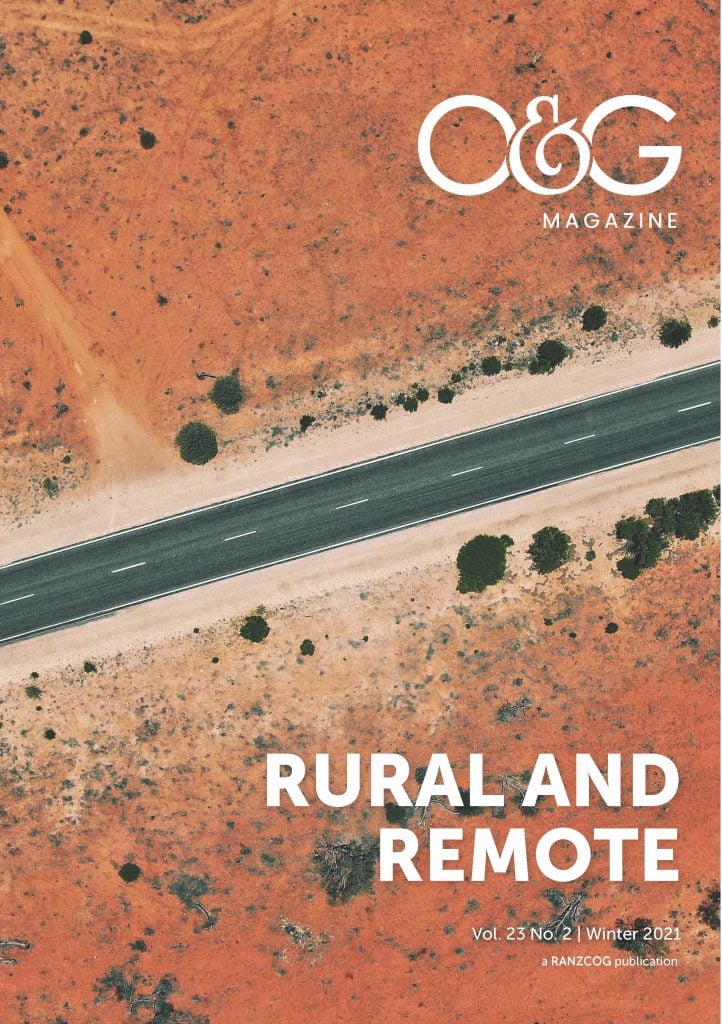Telehealth consultation should now be an integral part of outpatient care, especially for rural and remote patients.1 2 It offers convenience and benefits in providing clinical support, with maintenance of quality and safety standards.3
For patients, telehealth consultation:
- enables better access, especially for rural patients, avoiding the need to travel long distances with young children or where transport is difficult
- is time and cost efficient, especially for rural patients, reducing loss of time at work or school4
- ensures safety, avoiding the risk of car trips in rural sites and cross infection5
- reduces pollution through less travel 6
- enables inclusion of family members and health care professionals (HCPs), to join a consultation, perhaps from different sites. This enables development of the most efficient management plan with a local focus
- brings a specialist to a patient in a rural hospital or clinic, addressing the inequity of medical care experienced by rural and remote patients.
For the clinician, telehealth consultation enables:
- flexibility to consult from any site at convenient times, which is suitable for those working part-time and with other responsibilities
- better interprofessional connectivity and relevant learning opportunities, for regional specialists and rural GPs
- maintenance of local professional capability through supervised local management, boosting confidence in local services
- efficient use of time and cost compared with outreach clinics
- better social interaction and observation compared with a phone.
Specialty outpatient clinics delivered to rural or regional sites, involving HCPs with the patient, are an efficient and effective model of care and is appreciated by rural patients.7 Ideally the specialist will visit the site occasionally to build their relationship with the local HCPs and patients, and the community. Providing clinical tutorials via telehealth with the rural HCPs also helps build rapport.8
Telehealth should be the default option for the follow up of patients who live at a distance. It is best with a local HCP who can help with the assessment and enable handover of continuing care. New patients may be seen via telehealth9 10 where a history is provided, an examination may be supported by a rural generalist and a follow-up planned including the need for tests and in-person assessment.
For a specialist responding to a rural doctor asking about a patient with an acute problem, telehealth video consultation enables better assessment, with all involved and better meets quality and safety standards compared to a phone call.11 An urgent telehealth consultation is recommended for all requests for transfer or advice about rural patients.9 This reduces unnecessary transfers of acute patients, while enabling safe care in the local hospital, supervised by a specialist.12 13 A telehealth follow up of the rural inpatient, especially if there is a change of staff, is supportive for both the patient and HCPs and easily provided.
The choice of video-conferencing platform depends on experience and availability at either end. A simple and quick form of telehealth may be via FaceTime or WhatsApp, but a platform designed for telehealth, such as Attend Anywhere or Coviu, will work on any device with a click on a link and is preferable for regular use. It is a benefit to have a platform that has a virtual waiting room, so that if the clinician is late or the next patient early, there is no interruption to a consultation, the patient knows they are successfully linked, and the clinician knows the next patient is waiting. Screen sharing facility allows for showing of X-ray or other documents.
Practical points
It is important that telehealth bookings allow adequate time for consultations so they do not run into the next appointment. The clinician needs to be on time to avoid causing the patient frustration and uncertainty. Having time to prepare before consultations enables a confident and positive introduction and contributes to a successful and efficient telehealth exchange. This is especially true when the clinician is commencing to consult via telehealth.
Medicare supports telehealth to rural sites with the specialist fee plus an extra loading for the telehealth item 112. The Medicare website describes eligibility criteria and sites.14 During the COIVD pandemic Medicare eligibility for telehealth consultation to urban sites was introduced.15 Gathering patient details and providing information about logging in and fees is important at the time of booking a telehealth appointment. If a patient is to be billed, the credit card details should be sought before the consultation with a view to debiting it after the consultation. Having a co-ordinator who understands the telehealth process is important to the success of telehealth consultations, enabling the clinicians to concentrate on clinical issues.16
The site for the patient to best connect from will depend on a number of factors, including internet connectivity, patient confidence and if a GP or other professionals are involved. It may also depend on what equipment is used, which can be a laptop, tablet, phone or personal computer. If there is a delay linking via the expected platform, switching to FaceTime or WhatsApp may avoid loss of time. If there is difficulty with the audio in a videoconference, using a phone call for the audio while retaining the video link can work well.
The patient and clinician should be facing light or a window to ensure good visibility, avoiding illumination from behind. Ideally the camera should be at eye level, which may mean elevating a laptop. Looking at the camera when speaking to the patient establishes good eye contact. For the clinician providing regular telehealth, use of cordless headphones, or an external USB speaker and microphone, will ensure a better audio connection. Having two screens allows typing of digital records while maintaining vision of the patient. The audio, video and internet connections are best checked before consulting.
For after-hours or adhoc telehealth sessions, having an email template document can help and save time if there is no access to digital records. This ensures all patient information is recorded, which often does not occur with a phone response. This documentation can be emailed immediately to the referring HCP, patient, and others.
Scripts arising from the telehealth consultation are best scanned and emailed to the patient’s pharmacy, enabling same day medication, with a digital copy saved and the original posted to the pharmacy.17 Factsheets, lab forms, or website links may be sent to patients after the consultation.
Telehealth consultation is covered by medical insurance organisations to the same degree as an in-person consultation.18 Studies have demonstrated that safety and quality with telehealth consultation is achieved to the same level as in-person consultation.19 Much examination can be achieved via telehealth, such as gait and respiratory effort, and a clinician with the patient can undertake examination and clinical measurements requested by the telehealth consultant. Photos can help better visualise skin lesions or other features. Clinicians will consider what they may not achieve with telehealth and whether there is a need for in-person consultation.
Providing specialist support to patients in their communities with their HCPs reinforces the role of local rural generalists, upskilling them and thus reducing the workload within a specialist centre. 20 21 Some First Nations people may feel more comfortable with telehealth especially if they are supported by a health worker and family. This may be less threatening for them than having to travel to a regional site for a consultation in an unfamiliar hospital.
Telehealth specialist consultation is the preference for most rural and remote patients, especially if supported by a local HCP. Specialist outpatient consultation should incorporate telehealth, with regional on-call specialists providing the same availability for acute telehealth consultation to their catchment hospitals as they provide at their hospital. Providing access to telehealth is an important means of addressing inequity of healthcare for rural and remote patients.22 23
References
- Bradford NK, Caffery LJ, Smith AC. Telehealth services in rural and remote Australia: A systematic review of models of care and factors influencing success and sustainability. Rural Remote Health. 2016;16(4):3808.
- Lee S, Hitt W. Clinical Applications of Telemedicine in Gynecology and Women’s Health. PubMed Obstet Gynecol Clin N Am. 2020;47(2):259-70.
- National Safety and Quality Health Service Standards, Second Edition. Australian Commission on Safety and Quality in Health Care. 2017: Available from: www.safetyandquality.gov.au/sites/default/files/2019-04/. National-Safety-and-Quality-Health-Service-Standards-second-edition.pdf.
- Dullet NW, Geraghty EM, Kaufman T, et al. Impact of a university-based outpatient telemedicine program on time savings, travel costs, and environmental pollutants. Value Health 2017;20(4):542–6.
- Australian Medical Association. Expanded Telehealth Vital to Containing COVID-19 and Protecting Doctors and Their Patients. Canberra; The Australian Medical Association; 2020. Available from: www.ama.com.au/sites/default/files/documents/230320%20-%20Expanded%20Telehealth%20Vital%20to%20Containing%20Covid-19.pdf
- Dullet NW, Geraghty EM, Kaufman T, et al. Impact of a university-based outpatient telemedicine program on time savings, travel costs, and environmental pollutants. Value Health 2017;20(4):542–6.
- Williams M. Using telehealth for rural paediatric diabetics? Does it deliver good care? J Paed Ch Health. 2021;57(1):109-13.
- Smith B, Sward BL, Ellis Sk. Telemedicine and Distance Learning for Obstetician/Gynecologist Provider Education. Obstet Gynecol N Am. 2020;47(2):353-362.
- Lee S, Hitt W. Clinical Applications of Telemedicine in Gynecology and Women’s Health. PubMed Obstet Gynecol Clin N Am. 2020;47(2):259-70.
- Brown HL, DeNicola N. Telehealth in Maternity Care. Obstet Gynecol N Am. 2020;47(3):497-502.
- National Safety and Quality Health Service Standards, Second Edition. Australian Commission on Safety and Quality in Health Care. 2017: Available from: www.safetyandquality.gov.au/sites/default/files/2019-04/. National-Safety-and-Quality-Health-Service-Standards-second-edition.pdf.
- Brown HL, DeNicola N. Telehealth in Maternity Care. Obstet Gynecol N Am. 2020;47(3):497-502.
- Desai S, Williams M, Smith A. Teleconsultation from a secondary hospital for paediatric emergencies occurring in rural hospitals in Queensland. J Telemed Telecare. 2013;7(7):405-10.
- Services Australia. MBS and Telehealth. Canberra: Australian Government Services Australia; 2020. Available from: www.servicesaustralia.gov.au/organisations/health-professionals/services/medicare/mbs-and-telehealth.
- COVID-19 Teleheatlh Items Guide. Australian Government Department of Health; 2020. Available from: www.health.gov.au/sites/default/files/documents/2020/12/coronavirus-covid-19-telehealth-items-guide.pdf
- Edirippulige S, Armfield NR, Greenup P, Bryett A. Telehealth coordinators in hospital based telehealth services: Who are they and what do they do? J.Telemed Telecare. 2016;22(8):447-52.
- Prescriptions via telehealth – State and Territory Rules. Australian Government Department of Health; 2020. Available from: www.health.gov.au/sites/default/files/documents/2021/03/prescriptions-via-telehealth-state-and-territory-rules.pdf.
- Telehealth – What you should know. MIGA; 2020. Available from: www.migabulletin.com.au/article/telehealth-what-you-should-know/
- Lee S, Hitt W. Clinical Applications of Telemedicine in Gynecology and Women’s Health. PubMed Obstet Gynecol Clin N Am. 2020;47(2):259-70.
- Desai S, Williams M, Smith A. Teleconsultation from a secondary hospital for paediatric emergencies occurring in rural hospitals in Queensland. J Telemed Telecare. 2013;7(7):405-10.
- Ferrer RL, Hambidge SJ, Maly RC. The essential role of generalists in health care systems. Ann Intern Med. 2005;142(8):691-9.
- Bradford NK, Caffery LJ, Smith AC. Telehealth services in rural and remote Australia: A systematic review of models of care and factors influencing success and sustainability. Rural Remote Health. 2016;16(4):3808.
- Rural & remote-health. Australian Institute of Health and Welfare; 2019. Available from: www.aihw.gov.au/getmedia/918ae1b7-eeaf-4e64-9b88-36b887100a9e/Rural-remote-health.pdf.aspx?inline=true






Leave a Reply